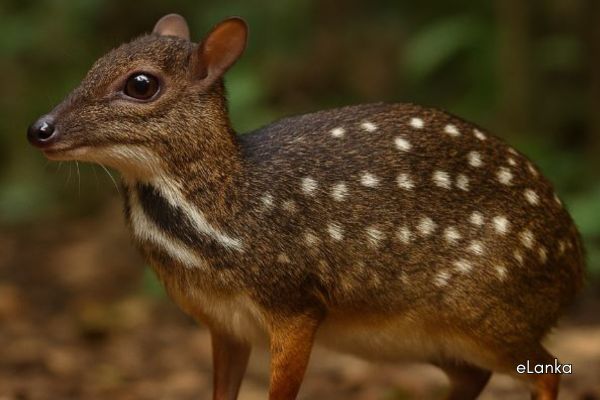The Sri Lankan Spotted Chevrotain: A Tiny, Mysterious Forest Gem – By Nadeeka- eLanka

Deep in the rainforests of Sri Lanka lives a creature so small and secretive that most people don’t even know it exists. Meet the Sri Lankan spotted chevrotain—also known as the mouse deer—a rare and fascinating animal that looks like a cross between a deer and something out of a fairytale.
Despite its delicate, deer-like appearance, the chevrotain isn’t technically a deer at all. In fact, it’s more closely related to animals like giraffes and camels. That might sound surprising, but this tiny forest dweller is full of surprises.
What Makes It So Unique?
The Sri Lankan spotted chevrotain holds the title of being the smallest hoofed mammal in the world. At just around 50 cm (20 inches) long, it’s no bigger than a rabbit or a small dog. Covered in smooth brown fur with delicate white spots, it blends almost perfectly with the forest floor, which helps it stay hidden from predators. When it moves, it does so carefully and silently, sometimes freezing for long moments to sense danger before continuing.
Unlike deer, chevrotains don’t have antlers. Their small, rounded bodies and big eyes give them an almost magical appearance, especially when spotted at night—when they’re most active.
Where Can You Find It?
This tiny treasure lives only in Sri Lanka and is typically found in wet zone forests in the southwest of the island. Places like Sinharaja Rainforest and Wilpattu National Park are known habitats. These areas are rich in dense vegetation, offering the perfect cover for this shy and secretive species.
Because they’re so quiet and elusive, seeing one in the wild is incredibly rare. Most of what we know about them comes from patient observation and camera traps hidden in the forest.
What Does It Eat?
The chevrotain is an herbivore, meaning it feeds only on plants. Its diet includes fallen fruits, tender leaves, and even mushrooms found on the forest floor. Since it’s a nocturnal animal, it prefers to search for food during the night when it’s cooler and safer to move around unnoticed.
A Species in Trouble
Sadly, the Sri Lankan spotted chevrotain is considered vulnerable, which means it’s at risk of becoming endangered. The biggest threat to its survival is habitat loss. As forests are cleared for farming, development, and logging, the chevrotain loses the safe, shady places it depends on for food and shelter.
Because it’s such a shy and small animal, it doesn’t adapt well to change. Without enough untouched forest, its future becomes uncertain.
Why It Matters
The Sri Lankan spotted chevrotain isn’t just another small animal in the woods—it’s a symbol of Sri Lanka’s rich biodiversity and an important part of its delicate ecosystem. Every animal, big or small, plays a role in keeping nature in balance. By protecting the forests where the chevrotain lives, we’re also protecting countless other species and the health of the environment as a whole.
How We Can Help
Protecting the chevrotain starts with protecting its habitat. Supporting forest conservation projects, saying no to illegal logging, and educating others about this rare species are all small but powerful steps we can take. The more people who know about the chevrotain, the better chance it has for survival.
A Tiny Treasure Worth Saving
The Sri Lankan spotted chevrotain may be small, but it’s one of the most unique and special animals in the world. With its spotted coat, secretive habits, and gentle ways, it reminds us just how magical nature can be. If we care enough to protect it, there’s hope that future generations will be able to admire this incredible little creature in the wild—not just in books or photos.
Quick Facts About the Sri Lankan Spotted Chevrotain
-
It measures about 50 cm (20 inches) in length—about the size of a rabbit
-
The white spots on its fur help it blend in with the forest floor
-
It’s nocturnal, so it’s mostly active at night
-
It can jump surprisingly well, helping it escape from predators
-
Lives only in Sri Lanka, primarily in wet zone forests
-
It’s listed as a vulnerable species due to habitat loss























